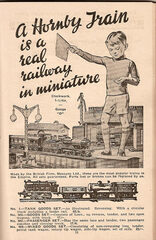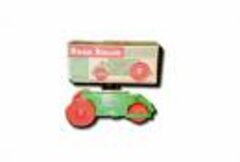
History Of Tin Toys

Ernst Plank
Nuremberg, Germany, 1866 - 1900.
Tin trains, airplanes, boats and cars.
Fisher-Price
Founded in 1930 by Herman Fisher, Irving Price and Helen Schelle, the name Fisher-Price was established by combining two of the three founders' names. Fisher worked previously in manufacturing, selling and advertising games for a company in Churchville, New York. Price had retired from a major variety chain store, and Helen Schelle previously operated Penny Walker Toy Shop in Binghamton, New York. Fisher-Price’s fundamental toy- making principles centered on intrinsic play value, ingenuity, strong construction, good value for the money, and action. Early toys were made of heavy steel parts and ponderosa pine, which resisted splintering and held up well to heavy use. The details and charm were added with colorful lithographic labels
In 1931, the three founders took 16 of their wooden toys to the International Toy Fair in New York City and they quickly became a success. The first Fisher-Price toy ever sold was "Dr. Doodle" in 1931; – the same toy, in excellent condition, would be worth a considerable amount in today's collectables market
Fleischmann
Fleischmann is a German manufacturer of model railroad products. Fleischmann was founded in Nuremberg in 1887 by Jean Fleischmann, as a toy company. Their first model train, in O scale, was produced in 1949. The first HO scale products were introduced in 1952 and the N scale "Piccolo" product line in 1969.

Gendron Wheel Company
Toledo, Ohio, 1872 to 1941.
In 1872, founder Pierre Gendron made the first "Pioneer" vehicle in a small workshop in his home near Toledo, Ohio. The company was originally organized with the purpose of manufacturing wire wheels. By 1920, in addition to wire wheels, Gendron was making baby carriages, tot's push cabs, and doll vehicles. With the increasing popularity of bicycle riding, Gendron manufactured a complete line of bikes. In 1928, Gendron Wheel Company, now recognized as one of the leaders in juvenile pedal vehicles.

AC Gilbert
Born in 1884, Alfred Carlton Gilbert entered Yale University Medical School at age 20 and helped support himself by performing magic shows. In 1908, Gilbert established the Mysto Magic Company with John Petrie, a machinist who had a mutual interest in magic and manufactured magic props. By 1909, they were manufacturing boxed sets of magic equipment for the wholesale trade. Gilbert took care of sales and promotion, while Petrie produced the magic sets. In 1911, Gilbert bought out Petrie and changed the direction of the company, turning his sights toward engineering and construction toys. His new Erector Sets were the first-ever American construction toys equipped with moving parts and motors. Introduced at the toy fairs of 1913, Erector Sets becamc an instant success, thanks in part to Gilbert's marketing savvy. He immediately initiated a media blitz with a series of ads in local and national magazines.
Links http://www.acghs.org/ http://www.eliwhitney.org/index2.htm

S.G. Gunthermann
Nuremberg, Germany, 1877 - 1965.
Gunthermann began producing mechanical cars in 1898 and also a number of comic and character wind-ups in the early 1960s.
|
|
|
Horikawa
One of the most prolific makers of Japanese battery operated toys was the Horikawa (1959) company who used the trade logo SH. Horikawa sold literally hundreds of different tin robots, rockets and space stations. In fact Horikawa sold so many different robots in the 1950's through 80's that new variations are being found regularly by collectors. While Horikawa is a well known name in Japanese toys, many don't realize that they were a wholesaler and not a manufacturer.
|
|
|
|
Hornby Railways is the leading brand of model railway in the United Kingdom. Its roots date back to 1901, when founder Frank Hornby received a patent for his Meccano construction toy.
Hornby, then known as Meccano Ltd and based in Liverpool, released its first train, a clockwork o guage(1:48) model, in 1920. An electric train soon followed but was under-designed and the few that were made were sold out in France. In 1925 a much more successful electric model was introduced , operating on high voltage (220-240V) AC power. Safety concerns saw low voltage 4V and then 6V motors introduced, followed by a reliable 20V AC system, which was developed in the early 1930s. However, clockwork remained the mainstay of the Hornby 0 gauge trains until 1937, and became the only power available in Liverpool-made 0 gauge trains from 1949.
A factory was established in France, which developed its own range of French outline trains, but Liverpool dominated export activity elsewhere, with large numbers of Hornby trains exported to Australia, New Zealand, Argentina and Scandinavia. Even though the export models were often painted in 'foreign' liveries, Hornby trains looked very British. Hornby attempted to break into the American market by setting up a factory in 1927 in Elizabeth, New Jersey, to make American-style trains. These were colourful and attractive, but low market and only clockwork. They probably would have failed in the marketplace because several established U.S. firms could undercut them and Hornby offered no better-class goods or electric models, but the Wall Street Crash precipitated matters. In late 1929, Meccano Ltd. sold its New Jersey factory to the A. C. Gilbert Company, and Hornby trains had vanished from the U.S. market by 1930. The leftover inventory was sold in Canada and in the UK, and some of the tooling was reused for products in other markets.

Links
http://www.modeltrains.net.au/hornby/
Hubley Mfg. Co.( Gabriel Industries.) 
The Hubley Manufacturing Company was incorporated in the early 1890s by John Hubley in Lancaster, Pennsylvania, and produced wonderful toys throughout its history. Early Hubley production consisted of numerous cast iron toys including various horse drawn vehicles, guns, household appliances, and more. With the automotive age, cars, trucks, and other transportation became their focus.
Early Hubley toys were cast iron, but after World War II the company switched to a die-cast zinc alloy. The trade name Kiddie Toys was used from 1946 through 1958.
In 1965, Hubley was sold to Gabriel Industries.
link




